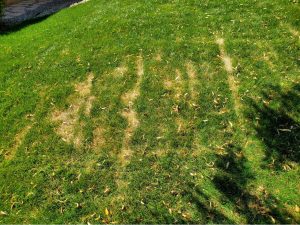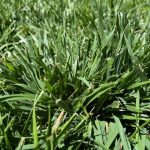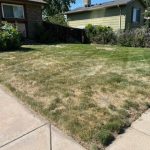Maintaining a lush, vibrant lawn is a source of pride for many homeowners. However, an unwelcome visitor can quickly turn that dream into a nightmare: leaf blight. This common lawn disease can wreak havoc on the health and appearance of your grass. While there are various causes one unexpected factor that can contribute to its occurrence is the tracks left behind by your lawn mower. In this blog, we will explore leaf blight, its causes, and the surprising link between mower tracks and this troublesome lawn disease.
Understanding Leaf Blight
Leaf blight is a fungal disease that affects the leaves of grass plants. It manifests as small, circular spots on the grass blades, which can range in color from brown to grayish-white. You will also notice that the ends of the blades begin to pinch and curl, similar to a burnt matchstick. The tips of the blade will have a white color that fades into a brown color. In severe cases, the affected leaves may turn yellow or brown and eventually die off.

Causes of Leaf Blight
Several factors contribute to the development of leaf blight, including environmental conditions, cultural practices, and the health of the lawn. Excessive moisture, high humidity, and prolonged periods of wetness provide an ideal environment for fungal growth. Poor air circulation, dense thatch, and compacted soil can also contribute to the development and spread of the disease. You will also start to see leaf blight when there are big fluctuations in temperature, which can be common in Colorado. If the day is warm and the evening is really cold or vice versa, this can be when you start to see signs of leaf blight in the lawn.
The Role of Mower Tracks
Do you ever notice that after mowing, you start to see the track marks in the lawn start to turn brown? Oftentimes, people will think gasoline was on the wheels and was tracked through the lawn causing burn marks. This isn’t the case, this is where you can see leaf blight occurring and spreading throughout the lawn. If you were to leave something heavy or even stand in the lawn for a duration of time, you may see those marks as well in the lawn because the fungus can occur in areas where the lawn has been stressed.
While it may come as a surprise, the tracks left behind by your lawn mower can play a significant role in the development of leaf blight. When a mower repeatedly travels over the same path, it compacts the soil beneath the wheels. This compaction not only inhibits proper root growth but also disrupts the natural drainage of water, leading to stagnant moisture in the affected areas. The combination of compacted soil and prolonged moisture creates an ideal breeding ground for causing fungi.
Furthermore, the repeated passage of a lawn mower over the same areas can physically injure the grass blades. These micro-injuries provide entry points for fungal spores, which then infect the grass and contribute to the development of leaf blight. Additionally, the clippings left behind by the mower can contain fungal spores, which further contribute to the spread of the disease as the mower disperses them across the lawn. 
Prevention and Management
Fortunately, there are steps you can take to prevent leaf blight and minimize its impact on your lawn:
Diversify your mowing pattern:
Avoid mowing the same path each time you mow. Varying your mowing direction and pattern helps prevent the compaction of soil and reduces the risk of leaf blight development.
Maintain proper mowing height:
Set your mower to the appropriate cutting height for your grass type. Keeping your grass at an optimal height promotes healthy growth, reduces stress, and helps prevent the spread of leaf blight.
Ensure good soil drainage:
Adequate soil drainage is crucial in preventing the stagnant moisture that contributes to leaf blight. Liquid aeration, which involves spraying an organic material over the lawn which will then penetrate through the soil and expands to help improve drainage and alleviate compaction.
Improve air circulation:
Trim or remove any overhanging branches or vegetation that obstructs air circulation over your lawn. Proper airflow helps prevent the buildup of excess moisture and reduces the likelihood of leaf blight.
Water wisely:
Proper watering practices are essential for preventing leaf blight. Avoid overwatering, as excessive moisture creates an ideal environment for fungal growth. Instead, water deeply and infrequently to encourage deep root growth and discourage the development of surface-level diseases. Water in the morning to allow the grass blades to dry throughout the day, reducing the risk of leaf blight infection.
Remove debris and thatch:
Regularly remove fallen leaves, grass clippings, and other debris from your lawn. This helps minimize the accumulation of moisture and fungal spores that can contribute to leaf blight. Additionally, periodically dethatching your lawn can prevent the buildup of excessive thatch, which can impede proper air circulation and increase the risk of disease.
Fungicide treatment:
In severe cases or when preventive measures are not sufficient, applying a fungicide specifically designed for leaf blight can help control the disease. Here at Erbert Lawns we offer a two part fungicide treatment. We apply a fungicide two weeks apart, this fungicide will prevent the fungus from spreading further. When this fungicide is applied, you want to wait to water for at least a few hours to allow the product to fully adhere to the blades of grass and then you want to be sure not to mow for 48 hours to allow the fungicide to fully treat the full blade.
Remember, prevention is always better than cure when it comes to leaf blight. By implementing a combination of preventive measures and appropriate management strategies, you can minimize the risk and maintain a beautiful, disease-resistant lawn.
Conclusion
Leaf blight is a troublesome lawn disease that can quickly diminish the beauty of your lawn. While there are various causes of this fungal infection, the presence of mower tracks is an often-overlooked contributing factor. By being aware of the potential link between mower tracks, soil compaction, and leaf blight, homeowners can take proactive measures to prevent the disease and maintain a healthy, vibrant lawn. Remember to diversify your mowing pattern, maintain proper mowing height, ensure good soil drainage, improve air circulation, and consider fungicide treatment when necessary. With these precautions in place, you can enjoy a lush, disease-free lawn that is the envy of the neighborhood.

Kelsey Keller
Business Manager
With six years of experience in lawn care, Kelsey Keller has learned the
many facets of what it takes to make lawn green and weed free. She pays close attention to
what customers need and what will make their lawn happy. She continues to learn and discover
what the turfs in Colorado need to be able to thrive.










